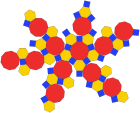| Truncated icosidodecahedron | |
|---|---|
 (Click here for rotating model) | |
| Type | Archimedean solid Uniform polyhedron |
| Elements | F = 62, E = 180, V = 120 (χ = 2) |
| Faces by sides | 30{4}+20{6}+12{10} |
| Conway notation | bD or taD |
| Schläfli symbols | tr{5,3} or |
| t0,1,2{5,3} | |
| Wythoff symbol | 2 3 5 | |
| Coxeter diagram | |
| Symmetry group | Ih, H3, [5,3], (*532), order 120 |
| Rotation group | I, [5,3]+, (532), order 60 |
| Dihedral angle | 6-10: 142.62° 4-10: 148.28° 4-6: 159.095° |
| References | U28, C31, W16 |
| Properties | Semiregular convex zonohedron |
 Colored faces |
 4.6.10 (Vertex figure) |
 Disdyakis triacontahedron (dual polyhedron) |
 Net |
In geometry, a truncated icosidodecahedron, rhombitruncated icosidodecahedron,[1] great rhombicosidodecahedron,[2][3] omnitruncated dodecahedron or omnitruncated icosahedron[4] is an Archimedean solid, one of thirteen convex, isogonal, non-prismatic solids constructed by two or more types of regular polygon faces.
It has 62 faces: 30 squares, 20 regular hexagons, and 12 regular decagons. It has the most edges and vertices of all Platonic and Archimedean solids, though the snub dodecahedron has more faces. Of all vertex-transitive polyhedra, it occupies the largest percentage (89.80%) of the volume of a sphere in which it is inscribed, very narrowly beating the snub dodecahedron (89.63%) and small rhombicosidodecahedron (89.23%), and less narrowly beating the truncated icosahedron (86.74%); it also has by far the greatest volume (206.8 cubic units) when its edge length equals 1. Of all vertex-transitive polyhedra that are not prisms or antiprisms, it has the largest sum of angles (90 + 120 + 144 = 354 degrees) at each vertex; only a prism or antiprism with more than 60 sides would have a larger sum. Since each of its faces has point symmetry (equivalently, 180° rotational symmetry), the truncated icosidodecahedron is a 15-zonohedron.
